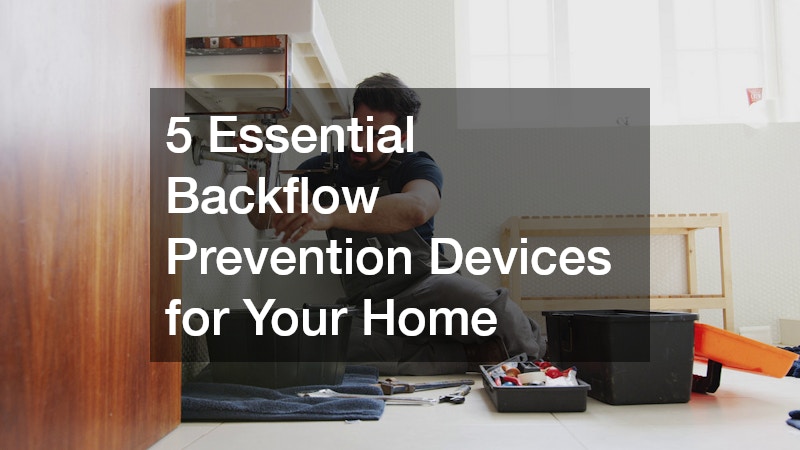Backflow in residential plumbing systems can pose serious health risks and lead to water contamination if not addressed properly. It occurs when used or contaminated water flows in reverse from its intended direction, entering the clean water supply. The most effective way to prevent this is by installing reliable backflow prevention devices. These mechanisms are designed to stop water from flowing backward into your home’s potable water system.
Understanding the essential types of these devices can help homeowners protect their water supply and comply with local regulations.
1. Air Gaps: A Simple Yet Effective Solution
Among the most straightforward and effective methods for preventing backflow is the air gap. This device isn’t mechanical, but rather a physical separation between the outlet of a water supply and the flood level of a receptacle. For instance, the space between a kitchen tap and the highest point of a sink basin is considered an air gap. This space prevents contaminated water from siphoning back into the clean water supply if there is a drop in pressure.
Air gaps are commonly used in dishwashers, sinks and water tanks. Their simplicity makes them highly reliable, as there are no moving parts that can wear out or fail over time. While they are typically mandated in many residential plumbing systems, they must be correctly installed and maintained to remain effective. Even a small modification to a sink or appliance can negate the benefits of an air gap if it causes the water outlet to dip too low.
2. Atmospheric Vacuum Breakers: Passive & Pressure-Free
An atmospheric vacuum breaker (AVB) is a compact and cost-effective solution that prevents back-siphonage. It is commonly installed on outdoor taps, garden irrigation systems and other fixtures where water could be drawn back into the domestic supply. The AVB uses a check valve and a vented air inlet to block the reverse flow of water when the supply pressure drops.
When water is flowing normally, the check valve remains open and the air inlet is closed. However, if the pressure in the water line drops, the check valve closes and the air inlet opens, breaking the vacuum and stopping backflow. Although effective, AVBs are best suited for low-risk applications and must be installed downstream from the last shutoff valve to function properly. Since they rely on atmospheric pressure, they cannot be used in pressurised systems or where continuous pressure is required.
3. Double Check Valve Assemblies: Balanced Protection
Double check valve assemblies (DCVAs) offer a more advanced form of protection, especially suitable for residential sprinkler systems, swimming pools and other outdoor plumbing setups. This type of backflow prevention device consists of two internal check valves placed in series. If the first valve fails, the second acts as a backup, significantly reducing the risk of contamination.
DCVAs are suitable for both back-siphonage and back-pressure conditions. They are typically installed underground in insulated enclosures or above ground in easily accessible valve boxes. Because they include test ports, they can be checked regularly by a licensed plumber to ensure functionality. While slightly more complex than simpler devices, DCVAs offer balanced protection and are a solid choice for moderate-risk backflow scenarios.
4. Reduced Pressure Zone Devices: The Gold Standard
For high-risk applications within residential plumbing systems, reduced pressure zone (RPZ) devices are considered the gold standard. These devices are specifically designed to offer maximum protection against both back-pressure and back-siphonage. An RPZ consists of two independently operating check valves with a relief valve placed between them. If both check valves fail, the relief valve opens to discharge contaminated water safely, preventing it from entering the potable water supply.
RPZs are typically used in households with fire sprinkler systems, large irrigation networks or connections to auxiliary water sources like rainwater tanks. They require professional installation and annual testing by a certified plumber to remain compliant with Australian standards. Although more expensive and bulky than other backflow prevention devices, their reliability makes them essential for homes with complex water systems or elevated risk factors.
5. Hose Bib Vacuum Breakers: Everyday Defence
One of the most overlooked sources of backflow is the humble garden hose. When left submerged in pools, buckets or other water sources, a garden hose can act as a conduit for contaminants to enter your home’s water supply. Hose bib vacuum breakers are small, screw-on devices fitted directly to outdoor taps. They contain a one-way valve that allows water to flow out but blocks it from reversing direction if the supply pressure drops.
Despite their simple design, hose bib vacuum breakers provide critical protection, especially in households with children, pets or where gardening and outdoor cleaning are routine. These devices are low-cost, easy to install and a must-have for any home aiming to maintain a clean water supply.
Safeguarding Your Water Supply with Backflow Prevention Devices
Choosing the right backflow prevention devices for your home depends on the layout of your plumbing system, the types of water outlets you have and your overall risk exposure. Devices such as air gaps and hose bib vacuum breakers are suitable for everyday use and require minimal upkeep. On the other hand, complex systems may demand the precision and reliability of reduced pressure zone devices or double check valve assemblies.
Whether you’re renovating your home or upgrading your outdoor plumbing, investing in backflow prevention devices is a proactive step toward a safer, healthier living environment. With the right setup, you can enjoy peace of mind knowing your water supply remains clean, secure and compliant with Australian plumbing standards.
.

